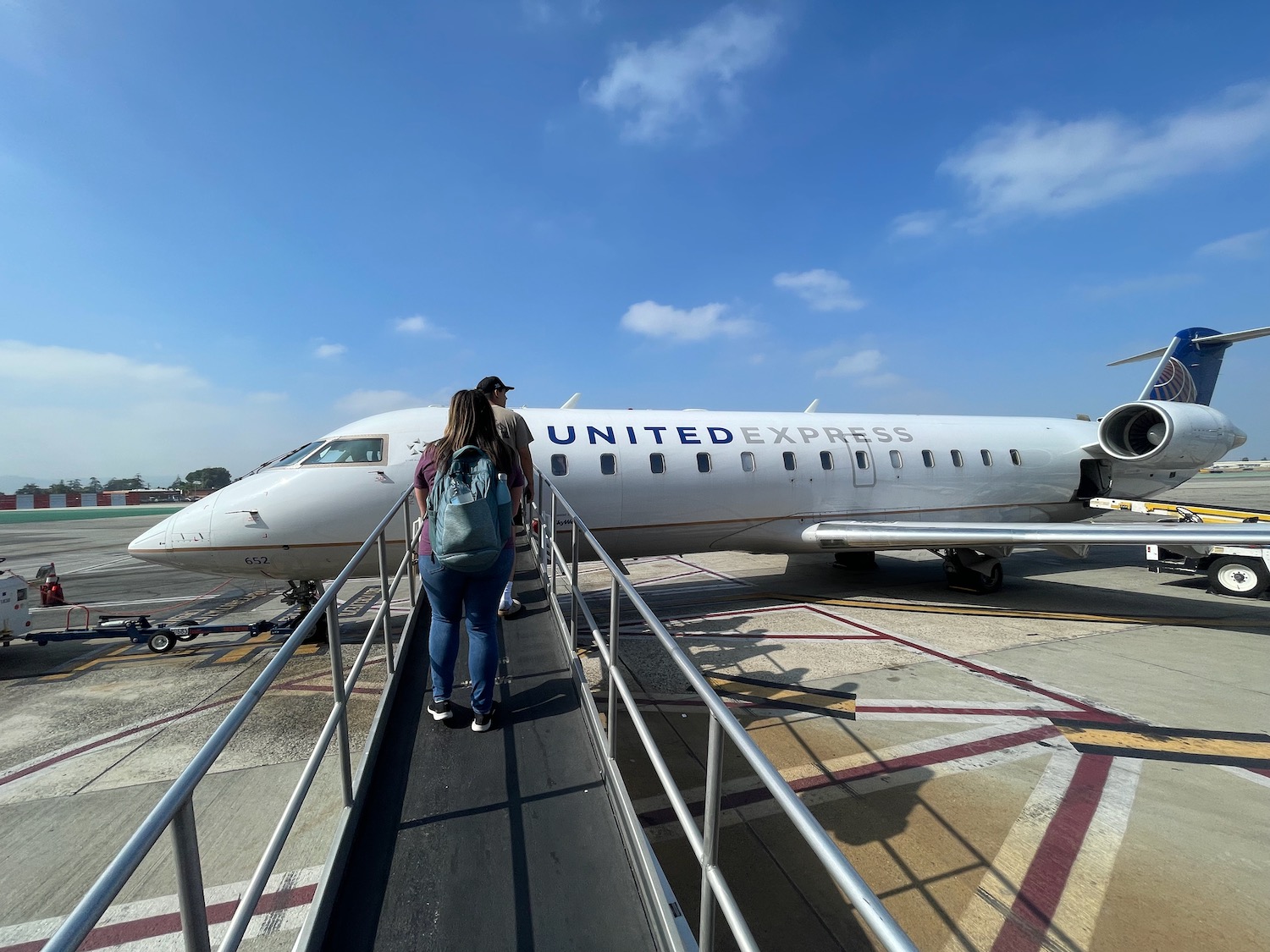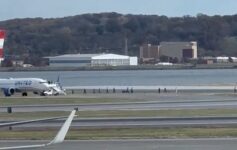
The ability of United Airlines to set up profitable flight banks and offer connectivity from smaller cities remains compromised due to a regional jet pilot shortage. However, United sees this problem stabilizing and has also indicated that it will, when possible, bring back more regional service via United Express.
United Airlines Sees Regional Jet Pilot Shortage Stabilizing But Still Hopes To Scale Up Regional Operations
The issue of regional jets came up frequently during an earnings call on April 19, 2023 and the color provided by United CCO Andrew Nocella helps to put the issue into perspective.
First, United is still well short of its 2019 flying levels when it comes to regional jets. Many small cities have lost air service over the last three years. Speaking to this, Nocella addressed the long-term goal:
“Rebuilding connectivity back to our original 2019 standards in our mid-con hubs and [Washington] Dulles will also be a long-term focus for our domestic volume. The loss of regional jets during the pandemic without mainline jets to backfill them cause connectivity to suffer. Peak bank sizes at our high flow hubs are down 10% to 20% versus 2019.”
Banking is the process by which arrivals and departures are clustered around specific times of day in order to maximize connectivity.
Asked by an analyst about how the lack of regional jets impacts the ability of United to maintain a flexible schedule, Nocella added:
“In terms of regional jets, the lack of regional jets has definitely hurt our connectivity. This is an issue. I talked about it, and we’re very focused on rebuilding that connectivity with the right jets going forward. And in fact, we don’t intend to ever go back to the fleet of approximately 600 regional jets we had in 2019. We think the economics have changed. We think the business has changed and we need to change with it.
“That being said, on the good news front, the regional jet pilot situation has recently – in our mind, stabilized. We’re no longer losing pilots at the same rate we were earlier – very early this year or last year. And the production of block hours in our regional jet division at the end of this year will be consistent with the production of block hours that we started the year with. And I can tell you that our original budget for that was not that. We thought we would continue to see deterioration. So the good news there is the regional jets are going to be able to at least temporarily help us boost our connectivity as we wait for all of our mainline jets from Boeing to deliver over the next two or so years.”
Importantly, Nocella shares that United is no longer losing regional jets pilots (to more lucrative mainline or foreign carriers) at the rate of 2022 and that this is contrary to expectations. It was logical to me that a simple supply-demand equilibrium would correct itself, with many new prospects entering pilot training on the basis of the high pay and high demand for commercial airline pilots. While a mass of retirements still looms in the years ahead due to the FAA’s mandatory retirement age of 65, is the pilot shortage improving?
In terms of connectivity, I am of the opinion that regional jets form an essential part of United’s long-term growth plan. As United takes delivery of hundreds of mainline jets, how does it realistically expect to fill them absent feeder flights from smaller cities, many of which have lost United Express service over the last three years? United is still a hub and spoke carrier. There simply is not sufficient demand from so many smaller airports to justify mainline flights, making regionals all the more important in supporting mainline growth.
CONCLUSION
United Airlines no longer sees the hemorrhaging of regional jet pilots that it and other carriers have experienced over the last two years. Even as the situation has stabilized, United is still markedly beyond its 2019 regional jet flying patterns. While the retirement of more 50-seat regional jets means that commercial air service may simply be unsustainable in certain markets, United hopes that a stabilizing pilot supply will lead to more regional jets flights in the months and years ahead.




I think both this and your other recent article about the earnings call identify Andrew Nocella incorrectly as COO
He’s the Chief Commercial Officer, which I abbreviated incorrectly. Thanks.
Still there are no 6 am or 7 am or 10 am LAX-SFO. The 8 am and 11 am are all we have. Because UA has to use mainline jets for routes that can’t quite fill up, like LAX-YVR. All due to regional pilot shortage.
No. These routes were all mainline before 9/11 and UA started using regional jets (or even Brasilias) on routes that would have been unthinkable before. The routes you mentioned are as they are because UA, and the other regional jet operators no longer throw capacity at markets in a suicidal attempt so somehow become profitable by selling its services at a loss and the existing capacity more accurately reflects the demand for tickets at a profitable price.
UA could fill in the flight times you mentioned with RJ’s, but given the unit costs of RJ’s vs. mainline, that would only serve to be a market share defense, not an actual “buy something and sell it for more” effort.
But I agree with @HkCaGu that not having a 6am flight to SFO is really big – means if I have an SF meeting I have to fly another carrier. That’s not ideal for a hub carrier.
I don’t think UA traditionally had an 0600 LAXSFO even before Covid and all that, but I could be wrong. Way, way back when UA used to have every other hour service SEALAX and SEASFO, but that was before overcapacity reared its ugly head.
UA tried that “We’ll lose money on a given flight, but we’ll keep it on because a handful of high rollers might want it” in the ’90’s and it was a disaster.
No offense to regional staff who are often great and grossly underpaid in many cases, but I just ever get excited to fly a CRJ/ERJ.
can never get excited* someday i’ll proofread
As a 2 mil miler and 67 years old, my crj days are over. Great folks, work their tales off. When I was 40 – fun. Now – no bueno. God love ‘um
Yes, they work hard in those small spaces. Once on American Eagle I had an FA who was so tall he was bent over the entire shift.. Literally could not stand up straight ever. No clue how they do it. Props to them for sure.
I really hope all regionals move to Embraer 175 or whatever else that is appropriate/similar. Breeze is good for this reason at least. I’d rather deal fly WN if that’s the choice–despite my last layover being a (formerly uncommon) legit five hour layover in BWI–to go up the east coast–then fly CRJ lol
Delta, United, and American can’t add more 76/70-seaters to their regional jet fleets. All three airlines are at their maximum number allowed under their pilot scope clauses and that isn’t going to change. Even during the worst of Covid, ALPA refused to allow any slack adhering to the contract and none of the contracts being finalized now provide for any relief for the airlines.
“Props to them for sure.”
I see what you did there!
😀
UAL only schedule 3 banks of domestic flights at Washington Dulles (early morning, noon, and 5pm-6pm), which is not that efficient and competitive as a hub. Let’s hope an extra flight bank be added when more regional flights are added.
You wouldn’t call the second round of Europe departures as well as some domestic around 10pm a bank?
Yes, there are some 10pm domestic departure at IAD, however, late night is not desirable time for most travellers. Since metro silver line finally connect Dulles airport, it now makes sense for UAL to schedule 4 daytime banks of domestic flights (8-9am, 11am-12pm, 2-3pm, 5-6pm).
By definition, a bank is not about local originating traffic. A 10:00 p.m. bank is boarding people who started their trip in their “spoke city” several hours ago.
REgardless of whether you think it’s a bank or not, the 10PM time slot IS a bank. I worked at United in the past, we considered it a bank, and it is a bank. It would be nice if they had more during the day, but as of now they dont. Perhaps that will change as things evolve.
But yes, it is a bank, and it flies several unique destinations that arent flown at other times, such as Sao Paulo, Tel Aviv, Amman, Dublin, Edinburgh, Lisbon, and extra flights to London, Frankfurt, and soon, Paris. Plus, Lufthansa’s Munich flight feeds/ gets feed from that bank. If that’s not a bank, I dont know what is.
I sure wish that United would get serious about expanding its regional service in California and quit forcing me to choose WN as often!
Only if UA pilots agree to not to limit the number of 70/75 seats regional jets in UA fleets.
That’s what they get for making me retire at 65. I could have flown for 2 more years and really helped out.
I agree there is likely flexibility here and that this needs to be looked at, but it also needs to be looked at by the right people so we can have a healthy balance of smart and safe. Still, I don’t see how it doesn’t happen considering the pilot shortage issue ahead.
& Thank you for your service and willingness to continue. We need more people like that who are willing to step up to help fix the many problems in aviation and also the world.
try to get in an out of ASpen is direct from some airports or from Denver…some days only 4 flights and they charge mega $$$ Den-ASe-Den can be over $1400 for a 28 minute flight too much monopoly by UAL
wow that’s cray
I wouldn’t be surprised if the upcoming pilots union contract includes a commitment to buy 100 seat planes as mainline aircraft. Something like the A220-100 or E195-E2 would be able to replace the higher traffic regional routes, and possibly some of the NY shuttle service.
UA has had pay rates for CR9’s , EMB190 and 195, and CS100 in their pilot contract since at least 2014 and has not seen fit to buy those planes.
Scott Kirby has said repeatedly that 100-ish seaters “don’t work”.